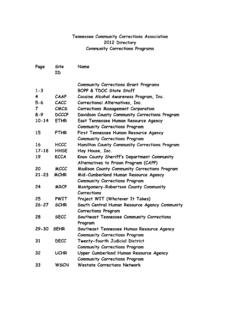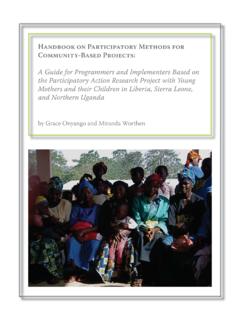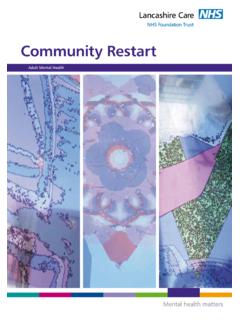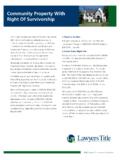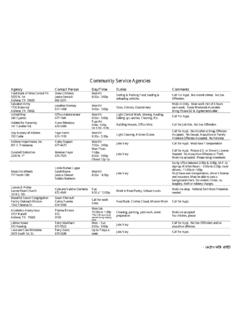Transcription of Action Strategies for Community Development
1 Action Strategies for This chapter will cover why this is so and what it means in terms of neighborhood Community Development planning. In politics one hears where you stand, depends on where you sit. The same can What Is Covered In This Chapter? be said about Strategies for neighborhood Development . The answers to fundamental The following topics will be addressed questions like: Where do we start? , below: What do we want to achieve? and How Lessons from a short history of do we get there? , will be much different neighborhood planning. depending upon where one is sitting in the A definition of social capital and why Community Development process.
2 Social capital is of critical importance to neighborhoods. Our starting point is the neighborhood Values that underlie Community organization - and that makes all the Development work. difference in building strong communities. Three different planning models for Community Development : Rational While the perspective of the book is Planning, Assets Based Community neighborhood residents and organizations, Development , and Community the approach is to create critical Organizing. We will talk about what partnerships among the many individuals they are, how they work, and in which dedicated to Community Development .
3 Situations they are used. These include Some long-term guidelines for neighborhood residents neighborhood Development activity. volunteers and paid staff of Community Roles of planners and roles of organizations like neighborhood organizers. groups, local churches, and Community Development Corporations employees of area or region-wide Community Development organizations like the local affordable housing builders and the Enterprise Foundation the staff members of school districts, city planning offices, social service agencies, health care providers, economic Development organizations, and other similar groups.
4 Many people working together are necessary based on a critical appreciation of the importance of neighborhood organizations and local residents. Dudley Street Neighborhood Initiative The stepping off point comes from the The needed critical partnership for inspiring efforts of a low income Community Community Development involves in Boston called the Dudley Street convergence of the work of many, Neighborhood. Their story is in a book titled coming together from neighborhood Streets of Hope. After many years of work, homes, businesses and churches; local Dudley Street residents said their strongest school rooms and offices, government tools were: the concept of the master plan agencies; banks and developers' offices.
5 And the Action of aggressive Community and many others. This coming together organizing. (Medoff & Sklar, ) requires an unwavering dedication to neighborhood improvement, social capital, 1. and empowerment. It also requires acre, about 30% greater than in Bombay, an understanding and sympathy for India at the time. Tenements often were the bureaucratic requirements of job poorly built and dangerous. By 1900, more descriptions, demands, and hierarchies. It than two-thirds of New Yorkers ( million means creatively engaging the programs of individuals) were living in tenements as large organizations like local governments defined by law.
6 (Ford, pp. 84, 187, 202). and school systems that reach out to communities, such as Community Oriented Policing and Community Schools. The approach is about openness, communication, creativity, empathy, patience, and flexibility. It is always with one's eyes on the prize of safe, enjoyable, and well-functioning neighborhoods. A Short History of Planning, or What Is Past Is Prologue . The field of urban planning began as neighborhood planning and had its roots in the teeming tenement districts of New York in the 19th Century. The city was a sleepy, mostly rural place in 1800 with only 60,000. residents.
7 As New York changed from a merchant and finance center to an industrial one, it expanded rapidly. There were once farms and cottages in the upper part of Lower East Side of Manhattan Manhattan. By 1860, the population grew to 814,000 and the city entered the 20th Compounding the press of sheer numbers century with 1,850,000 residents. (Ford, was the virtual absence of sanitary sewer Slums & Housing, pp. 72-79, 140) and water facilities. Privies were located in tenement basements and in small open Confronted by this rising tide of humanity, areas between buildings on the small lots. property owners greedy for quick wealth By the close of the century, the City was prevailed on the New York Commission to described as one elongated cesspool.
8 Subdivide the city into a grid block system Regular epidemics of typhus, typhoid, of 25' x 100' lots. This was the most yellow fever, cholera, dysentery, and flexible and marketable subdivision of land smallpox broke out. (Ford, p. 130). ( the most cheap to build ) and few sites were left for public facilities. Into this In the midst of this squalor, urban planning dense grid were built the housing tenement emerged from the activities of the buildings often two buildings to a lot, each Settlement House workers. The first rising four to seven stories. One floor of Settlement House was University Settlement the tenement typically contained four small established by Stanton Coit in 1886 in the apartments with two rooms (sometimes 12' Lower East Side of Manhattan.)
9 The first x 10' and 10' x 6' in size). Each room might Settlement workers were from the middle contain as many as six persons. Owners or wealthier classes, inspired by religious were dividing the living spaces into the tenets of service, and lived among the smallest area capable of holding human life. people whose lives they worked to improve. By 1890, one section of New York had an (Coit in Pacey, Readings in the Development average density of nearly 1,000 persons per of Settlement Work). 2. Their goals and circumstances in these but had little impact on over-all conditions neighborhoods drew them into a wide range because a handful of good dwelling were of Community improvement efforts.
10 (Lurie, built while tens of thousands of slum units Encyclopedia of Social Work, p. 690) These were raised. (Ford, p. 202) Some of the included: commentaries seemed to place blame on availability of regular education, immigrants for their condition: congregated kindergarten, pre-school, and after- armies of foreigners .. They bring with school programs; them destitution, misery, and too often recreation, parks and playgrounds; disease. (DeForest & Veiller, The Tenement sanitation, potable water, and garbage Housing Problem, p. 72). collection;. libraries; It was not until an effective political public safety; force coalesced between 1884 and 1901, legal aid; uniting the housing reformers, Settlement social services for the elderly, homeless, House workers, social service groups, and the disabled; Community and religious leaders, that health care; progress was made.
